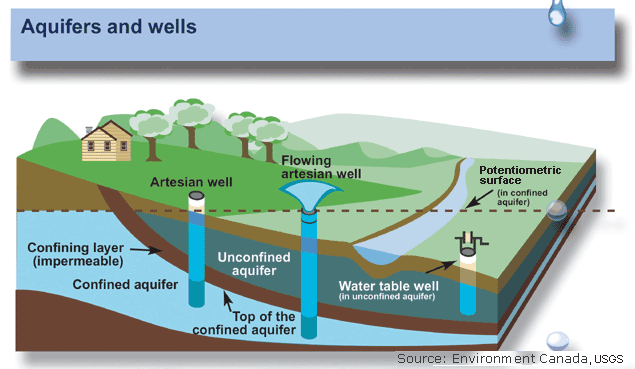|
A common misconception of potential well owners is the difference between surface water and groundwater, and how one can affect the other. Here is a short lesson to better educate you on where your water comes from.
Surface water is found in lakes, ponds, and streams or in wells dug just below the ground. Groundwater is found under the Earth’s surface, drilled hundreds of feet below the soil. Groundwater is commonly used for drinking, washing, and cooking, whereas surface water is generally used for agriculture and generating electricity. Groundwater, however, maintains a constant temperature year round- great for using geothermal energy to heat and cool your home. It can also be determined that surface water is more susceptible to evaporation, leaving lakes and ponds looking low during an extremely dry season. Groundwater, on the other hand, is not directly affected. As a matter of fact, some surface water actually seeps into the ground and “recharges” the water aquifer under the bedrock and water table, where your well water comes from. Groundwater is also free of pathogens like Malaria and Salmonella, unlike some surface water sources. A drilled well has many advantages when providing water to your home or business. Before being dispensed from a faucet, your well water is pumped through a filtration system and disinfected. However, it is not treated with harsh chemicals used in public water systems; just all natural water.
30 Comments
As temperatures are starting to drop, it is important that you insulate your well pipes and casing.
When pipes freeze, the flow of water is completely blocked. As the water expands to ice, pipes can burst and causes the potential to ruin your pump deep within the ground. This damage could be extremely expensive. So before the sun goes down and freezing temperatures set in, be sure to insulate your pipes and casings. If your well does not have a cover for protection or if you are simply looking for additional insulation from the cold weather, here are a few tips to keep your water flowing and your pump working properly.
If you experience damages to your well or pump from frozen pipes or cold weather, call Croft Drilling Services for expert advice and emergency repairs. |
Archives |
© 2020 Gill Drilling Services INC. All Rights Reserved.


